Reusing Dredged Material through Stabilization with So-Called Bio-Enzyme Products
Abstract
:1. Introduction
2. Results and Discussion
2.1. Chemical Toxicity Tests
2.2. Untreated Dredged Material
2.3. Effect of Stabilization on Physical Properties
2.3.1. Unconfined Compressive Strength (UCS)
2.3.2. Consistency Limits
2.3.3. Compaction Characteristics
2.4. Field Study
2.4.1. Road Test Lanes
2.4.2. Moisture–Density Relation and Cracking Behavior
2.4.3. California Bearing Ratio (CBR)
2.5. Statistical Study
2.5.1. ANOVA of the California Bearing Ratio (CBR)
2.5.2. ANOVA of the Unconfined Compressive Strength (UCS)
2.5.3. Scanning Electron Microscopy (SEM)
3. Materials and Methods
3.1. Sample Preparation and Testing
3.2. Field Test
4. Conclusions
Author Contributions
Funding
Data Availability Statement
Acknowledgments
Conflicts of Interest
References
- Millrath, K.; Kozlova, S.; Shimanovich, S.; Meyer, C. Beneficial Use of Dredged Material 2; Progress report prepared for Echo Environmental, Inc.; Columbia University: New York, NY, USA, 2001. [Google Scholar]
- Rahimikelarijani, B.; Abedi, A.; Hamidi, M.; Cho, J. Simulation Modeling of Houston Ship Channel Vessel Traffic for Optimal Closure Scheduling. Simul. Model. Pract. Theory 2018, 80, 89–103. [Google Scholar] [CrossRef]
- Kennedy, C.C. History of Dredged Material Management and Usage in the United States. In Proceedings of the 18th World Congress of Soil Science, Philadelphia, PA, USA, 9–15 July 2006. [Google Scholar]
- Kestler, M.A. Stabilization Selection Guide for Aggregate-and Native-Surfaced Low-Volume Roads; US Department of Agriculture, Forest Service, National Technology & Development Program; BiblioGov: Columbus, OH, USA, 2009. [Google Scholar]
- Mitchell, J.K. Practical Problems from Surprising Soil Behaviour. J. Geotech. Engrg. 1986, 112, 259–289. [Google Scholar]
- Conner, J.R. ChemicalFixation and Solidificationof Hazardous Wastes; Van Nostrand Reinhold: New York, NY, USA, 1990; Volume 692, p. 335. [Google Scholar]
- Manzenrieder, H.A.; De Vries, J.M. Dredging and Disposal within the Limits of a National Park. In Coastal Engineering; ASCE: Reston, VA, USA, 1997; pp. 4274–4288. [Google Scholar]
- Crowe, S.E.; Gayes, P.T.; Viso, R.F.; Bergquist, D.C.; Jutte, P.C.; Van Dolah, R.F. Impact of the Charleston Ocean Dredged Material Disposal Site on Nearby Hard Bottom Reef Habitats. Mar. Pollut. Bull. 2010, 60, 679–691. [Google Scholar] [CrossRef]
- Francingues, N.R.; Thompson, D.W. Innovative Dredged Sediment Decontamination and Treatment Technologies; US Army Engineer Research and Development Center: Vicksburg, MS, USA, 2000. [Google Scholar]
- Lee, C.R. Case Studies: Characterization Tests to Determine Dredged Material Suitability for Beneficial Uses; US Army Engineer Research and Development Center [Environmental Laboratory]: Vicksburg, MS, USA, 1999. [Google Scholar]
- Board, M. Contaminated Sediments in Ports and Waterways: Cleanup Strategies and Technologies; National Academies Press: Washington, DC, USA, 1997; ISBN 0309054931. [Google Scholar]
- Solanki, P.; Jain, B.; Hu, X.; Sancheti, G. A Review of Beneficial Use and Management of Dredged Material. Waste 2023, 1, 815–840. [Google Scholar] [CrossRef]
- Chiu, C.F.; Zhu, W.; Zhang, C.L. Yielding and Shear Behaviour of Cement-Treated Dredged Materials. Eng. Geol. 2009, 103, 1–12. [Google Scholar] [CrossRef]
- Beeghly, J.; Schrock, M. Dredge Material Stabilization Using the Pozzolanic or Sulfo-Pozzolanic Reaction of Lime by-Products to Make an Engineered Structural Fill. Int. J. Soil Sediment Water 2010, 3, 6. [Google Scholar]
- Federico, A.; Vitone, C.; Murianni, A. On the Mechanical Behaviour of Dredged Submarine Clayey Sediments Stabilized with Lime or Cement. Can. Geotech. J. 2015, 52, 2030–2040. [Google Scholar] [CrossRef]
- Grubb, D.G.; Chrysochoou, M.; Smith, C.J.; Malasavage, N.E. Stabilized Dredged Material. I: Parametric Study. J. Geotech. Geoenviron. Eng. 2010, 136, 1011–1024. [Google Scholar] [CrossRef]
- Milburm, J.P.; Parsons, R.L. Performance of Soil Stabilization Agents; Kansas Department of Transportation: Topeka, KS, USA, 2004. [Google Scholar]
- Nguyen, T.T.M.; Rabbanifar, S.; Brake, N.A.; Qian, Q.; Kibodeaux, K.; Crochet, H.E.; Oruji, S.; Whitt, R.; Farrow, J.; Belaire, B. Stabilization of Silty Clayey Dredged Material. J. Mater. Civ. Eng. 2018, 30, 4018199. [Google Scholar] [CrossRef]
- Tingle, J.S.; Larson, S.L.; Weiss, C.A.; Newman, J.K.; Peters, J.F. Constitutive Analyses of Nontraditional Stabilization Additives; Engineer Research and Development Center: Vicksburg, MS, USA, 2004. [Google Scholar]
- Nguyen, T.T.M.; Rabbanifar, S.; Luo, Z.; Huddleston, C.; O’Connor, T.; Richard, A.; Michel, M.; Moon, R.; Yao, C.W.; Jao, M.; et al. Development of Fiber Reinforced Sustainable Dredge Bricks. Appl. Sci. 2023, 13, 789. [Google Scholar] [CrossRef]
- Abriak, Y.; Maherzi, W.; Benzerzour, M.; Senouci, A.; Rivard, P. Valorization of Dredged Sediments and Recycled Concrete Aggregates in Road Subgrade Construction. Buildings 2023, 13, 646. [Google Scholar] [CrossRef]
- Shi, J.; Wang, S.; Cao, W.; Su, J.; Zhang, X. Mechanical Properties and Strengthening Mechanism of Dredged Silty Clay Stabilized by Cement and Steel Slag. Materials 2022, 15, 3823. [Google Scholar] [CrossRef] [PubMed]
- Develioglu, I.; Pulat, H.F. Compressibility Behaviour of Natural and Stabilized Dredged Soils in Different Organic Matter Contents. Constr. Build. Mater. 2019, 228, 116787. [Google Scholar] [CrossRef]
- Cheng, X.; Chen, Y.; Chen, G.; Li, B. Characterization and Prediction for the Strength Development of Cement Stabilized Dredged Sediment. Mar. Georesour. Geotechnol. 2021, 39, 1015–1024. [Google Scholar] [CrossRef]
- Zhu, X.; Niu, F.; Ren, L.; Jiao, C.; Jiang, H.; Yao, X. Effect of Calcium Carbide Residue on Strength Development along with Mechanisms of Cement-Stabilized Dredged Sludge. Materials 2022, 15, 4453. [Google Scholar] [CrossRef]
- Wang, S.; He, X.; Cai, G.; Lang, L.; Ma, H.; Gong, S.; Niu, Z. Investigation on Water Transformation and Pore Structure of Cement-Stabilized Dredged Sediment Based on NMR Technology. Materials 2022, 15, 3178. [Google Scholar] [CrossRef] [PubMed]
- Wright-Fox, R.; Macfarlane, J.G.; Bibbens, R.F. Alternate Chemical Soil Stabilisers; Minor Research Report; CalTrans: Sacramento, CA, USA, 1993. [Google Scholar]
- Rauch, A.; Harmon, J.; Katz, L.; Liljestrand, H. Measured Effects of Liquid Soil Stabilizers on Engineering Properties of Clay. Transp. Res. Rec. J. Transp. Res. Board 2002, 1787, 33–41. [Google Scholar] [CrossRef]
- Renjith, R.; Robert, D.J.; Gunasekara, C.; Setunge, S.; O’Donnell, B. Optimization of Enzyme-Based Soil Stabilization. J. Mater. Civ. Eng. 2020, 32, 4020091. [Google Scholar] [CrossRef]
- Marasteanu, M.O.; Hozalski, R.M.; Clyne, T.R.; Velasquez, R. Preliminary Laboratory Investigation of Enzyme Solutions as a Soil Stabilizer; University of Minnesota Digital Conservancy: Minneapolis, MN, USA, 2005; pp. 1–102. [Google Scholar]
- Mekonnen, E.; Kebede, A.; Tafesse, T.; Tafesse, M. Application of Microbial Bioenzymes in Soil Stabilization. Int. J. Microbiol. 2020, 2020, 1725482. [Google Scholar] [CrossRef]
- Parsons, R.; Milburn, J. Engineering Behavior of Stabilized Soils. Transp. Res. Rec. J. Transp. Res. Board 2003, 1837, 20–29. [Google Scholar] [CrossRef]
- Tremblay, H.; Leroueil, S.; Locat, J. Mechanical Improvement and Vertical Yield Stress Prediction of Clayey Soils from Eastern Canada Treated with Lime or Cement. Can. Geotech. J. 2001, 38, 567–579. [Google Scholar] [CrossRef]
- Rabbanifar, S.; Nguyen, T.T.M.; Yao, C.-W.; Qian, Q.; Bernazzani, P.; Jao, M. Adding Value to Dredged Material Using Lime and Ash Products. In Proceedings of the Recent Trends in Geotechnical Geo-Environmental Engineering and Education RTG2EE International Conference, Online, 15–17 July 2020; pp. 94–98, ISBN 13-978-0-6489449-0-4. [Google Scholar]
- Umar, I.H.; Lin, H.; Ibrahim, A.S. Laboratory Testing and Analysis of Clay Soil Stabilization Using Waste Marble Powder. Appl. Sci. 2023, 13, 9274. [Google Scholar] [CrossRef]
- James, J.; Vijayasimhan, S.; Eyo, E. Stress-Strain Characteristics and Mineralogy of an Expansive Soil Stabilized Using Lime and Phosphogypsum. Appl. Sci. 2023, 13, 123. [Google Scholar] [CrossRef]
- Mwandira, W.; Purchase, D.; Mavroulidou, M.; Gunn, M.J. Synthesis and Utilisation of Hybrid Metal-Carbonic Anhydrase Enzyme Carrier System for Soil Biocementation. Appl. Sci. 2023, 13, 9494. [Google Scholar] [CrossRef]
- Bergmann, R. Soil Stabilizer for Use on Universally Accessible Trails; USDA Forest Service, San Dimas Technology and Development Center: San Dimas, CA, USA, 1995. [Google Scholar]
- Shukla, M.; Bose, S.; Sikdar, P.K. Bio-Enzyme for Stabilization of Soil in Road Construction a Cost Effective Approach; Integrated development of rural and arterial road networks for socio-economic development; IRC Seminar: New Delhi, India, 2003. [Google Scholar]
- Isaac, K.P.; Biju, P.B.; Veeraragavan, A. Soil Stabilization Using Bio-Enzyme for Rural Roads. In Proceedings of the Conference by the Indian Road Congress, New Delhi, India, 5–6 December 2003. [Google Scholar]
- Agarwal, P.; Kaur, S. Effect of Bio-Enzyme Stabilization on Unconfined Compressive Strength of Expansive Soil. Int. J. Res. Eng. Technol. 2014, 3, 30–33. [Google Scholar]
- Nandini, D.; Amate, V.; Kumar, M.P. Compaction and Strength Characteristics of Terra-Zyme Stabilized Red Soil. Int. J. Res. Publ. Eng. Technol. Manag. 2015, 1, 1–3. [Google Scholar]
- Sen, J.; Singh, J.P. Stabilization of Black Cotton Soil Using Bio Enzyme for a Highway Material. Int. J. Innov. Res. Sci. Eng. Technol. 2015, 4, 553. [Google Scholar]
- Brandon, F.; Ding, C.; Gary, H.; Charles, R. Permazyme Testing Volume I: Final Testing Summary Report; California Pavement Preservation Center: Chico, CA, USA, 2010. [Google Scholar]
- Guthrie, W.S.; Simmons, D.O.; Eggett, D.L. Enzyme Stabilization of Low-Volume Gravel Roads. Transp. Res. Rec. J. Transp. Res. Board 2015, 2511, 112–120. [Google Scholar] [CrossRef]
- Khan, T.A.; Taha, M.R. Effect of Three Bioenzymes on Compaction, Consistency Limits, and Strength Characteristics of a Sedimentary Residual Soil. Adv. Mater. Sci. Eng. 2015, 2015, 798965. [Google Scholar] [CrossRef]
- Peng, H.T.; Su, H.T.; Zhang, X.P.; Wang, J. An Experimental Comparison of Compressive Strengths of Soils Stabilized with Enzyme and Ground Quicklime. Adv. Mater. Res. 2011, 280, 9–12. [Google Scholar] [CrossRef]
- Ramesh, H.N.; Sagar, S.R. Effect of Drying on the Strength Properties of Terrazyme Treated Expansive and Non-Expansive Soils. In Proceedings of the 50th Indian Geotechnical Conference, Maharashtra, India, 17–19 December 2015. [Google Scholar]
- Shankar, A.U.; Rai, H.K.; Mithanthaya, R. Bio-Enzyme Stabilized Lateritic Soil as a Highway Material. Indian Roads Congr. J. 2009, 70. [Google Scholar]
- Brazetti, R.; Murphy, S.R. General Usage of Bio-Enzyme Stabilizers in Road Construction in Brazil. In Proceedings of the 32nd Annual Meeting on Paving, Brasília, Brazil, 15–19 October 2000; pp. 2–12. [Google Scholar]
- Abedin, M.Z.; Tang Lon Mood, J.; Jurutesa, J.S. An attempt to improve Plantation Road Soils Using an Organic Stabilizer. Soc. Malays. Bull. 2003, 46, 59–62. [Google Scholar] [CrossRef]
- Katz, L.; Rauch, A.; Liljestrand, H.; Harmon, J.; Shaw, K.; Albers, H. Mechanisms of Soil Stabilization with Liquid Ionic Stabilizer. Transp. Res. Rec. J. Transp. Res. Board 2001, 1757, 50–57. [Google Scholar] [CrossRef]
- Petry, T.; Das, B. Evaluation of Chemical Modifiers and Stabilizers for Chemically Active Soils—Clays. Transp. Res. Rec. J. Transp. Res. Board 2001, 1757, 43–49. [Google Scholar] [CrossRef]
- Scholen, D.E. Non-Standard Stabilizers; United States. Federal Highway Administration. Office of Direct Federal Programs: Washington, DC, USA, 1992. [Google Scholar]
- Zhao, H.; Ge, L.; Petry, T.M.; Sun, Y.-Z. Effects of Chemical Stabilizers on an Expansive Clay. KSCE J. Civ. Eng. 2014, 18, 1009–1017. [Google Scholar] [CrossRef]
- Ji, X.; Ma, Y.; Zeng, G.; Xu, X.; Mei, K.; Wang, Z.; Chen, Z.; Dahlgren, R.; Zhang, M.; Shang, X. Transport and Fate of Microplastics from Riverine Sediment Dredge Piles: Implications for Disposal. J. Hazard. Mater. 2021, 404, 124132. [Google Scholar] [CrossRef]
- Thurnau, R.C. Low-Temperature Desorption Treatment of Co-Contaminated Soils: TCLP as an Evaluation Technique. J. Hazard. Mater. 1996, 48, 149–169. [Google Scholar] [CrossRef]
- Booth, J.S.; Dahl, A.G. A Note on the Relationships between Organic Matter and Some Geotechnical Properties of a Marine Sediment. In Marine Geotechnology; Taylor & Francis: Abingdon-on-Thames, UK, 1986. [Google Scholar]
- Huang, P.-T.; Bobet, A.; Santagata, M. Identification of Low-Organic-Content Soils: An Engineering Approach. Geotech. Test. J. 2012, 35, 596–606. [Google Scholar] [CrossRef]
- Keller, G.H. Organic Matter and the Geotechnical Properties of Submarine Sediments. Geo-Marine Lett. 1982, 2, 191–198. [Google Scholar] [CrossRef]
- Venkatasubramanian, C.; Dhinakaran, G. Effect of Bio-Enzymatic Soil Stabilisation on Unconfined Compressive Strength and California Bearing Ratio. J. Eng. Appl. Sci. 2011, 6, 295–298. [Google Scholar]
- Maher, A.; Douglas, W.S.; Jafari, F.; Pecchioli, J. The Processing and Beneficial Use of Fine-Grained Dredged Material. In A Manual for Engineers; Citeseer: Princeton, NJ, USA, 2013. [Google Scholar]
- Gayatri, N.; Shyla, J. Effect of Bioenzyme and Geotextile on Strength Characteristics of Subgrade Soil. Int. Res. J. Eng. Technol. 2016, 3, 1891–1897. [Google Scholar]
- Mymrin, V.; Stella, J.C.; Scremim, C.B.; Pan, R.C.Y.; Sanches, F.G.; Alekseev, K.; Pedroso, D.E.; Molinetti, A.; Fortini, O.M. Utilization of Sediments Dredged from Marine Ports as a Principal Component of Composite Material. J. Clean. Prod. 2017, 142, 4041–4049. [Google Scholar] [CrossRef]
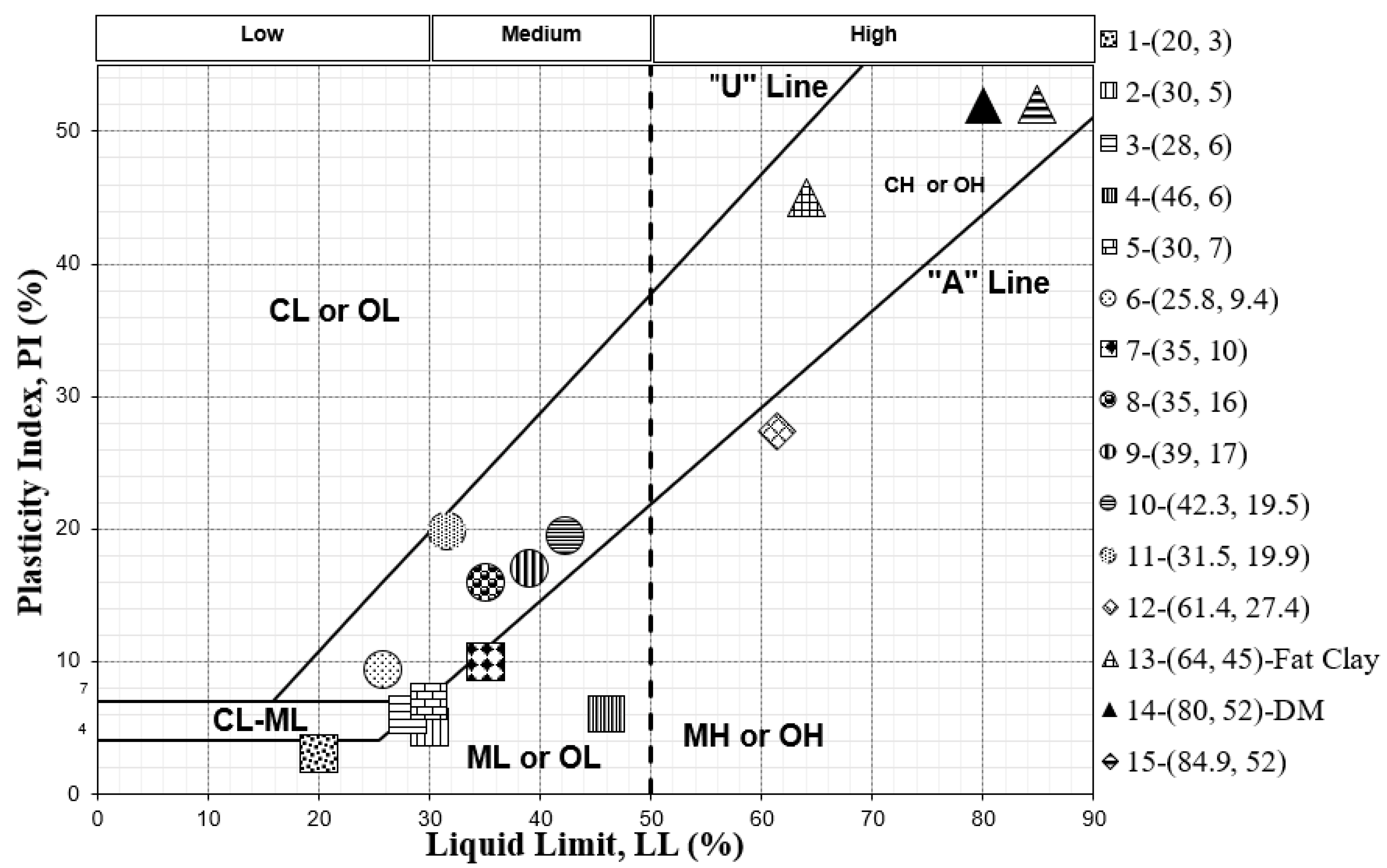


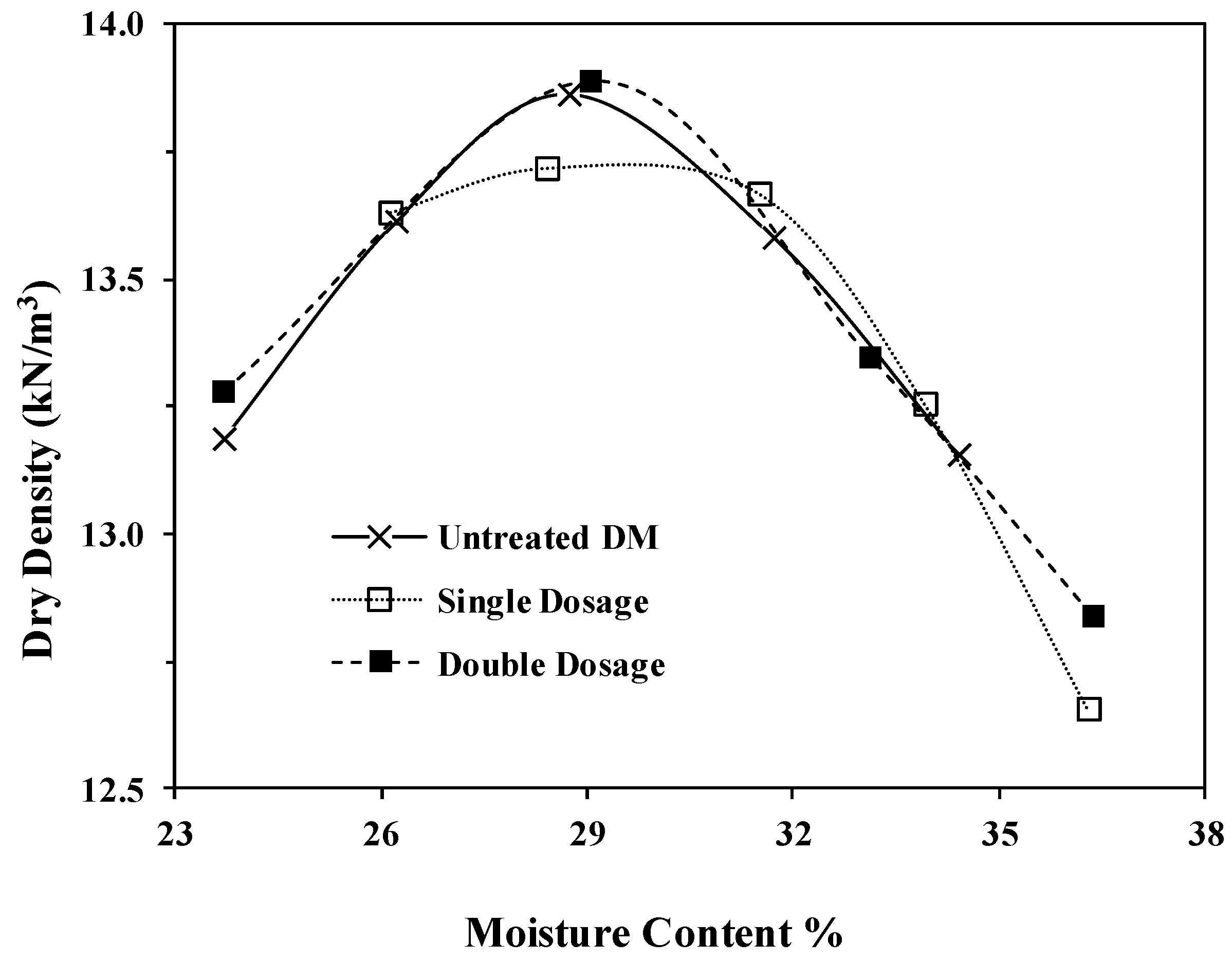
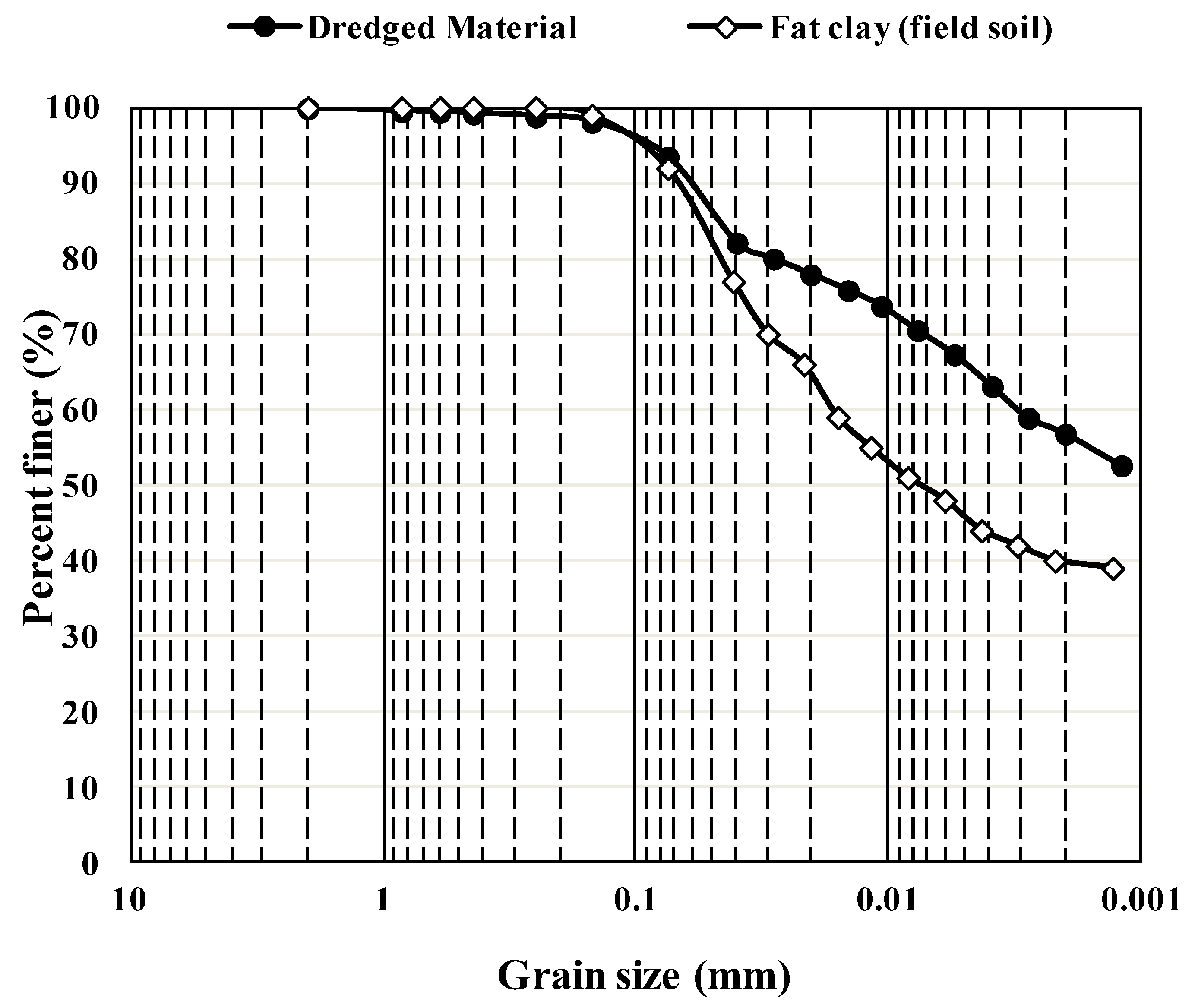

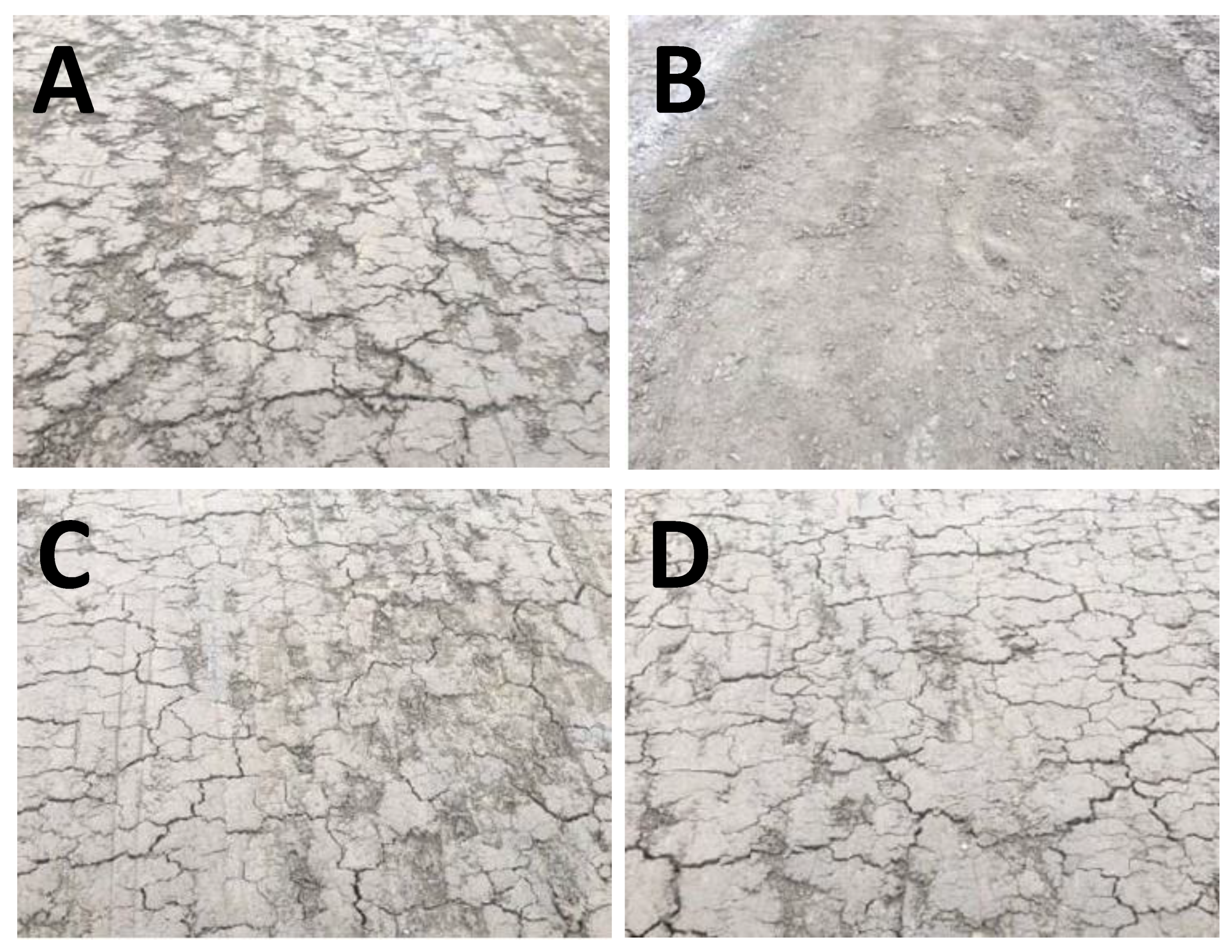

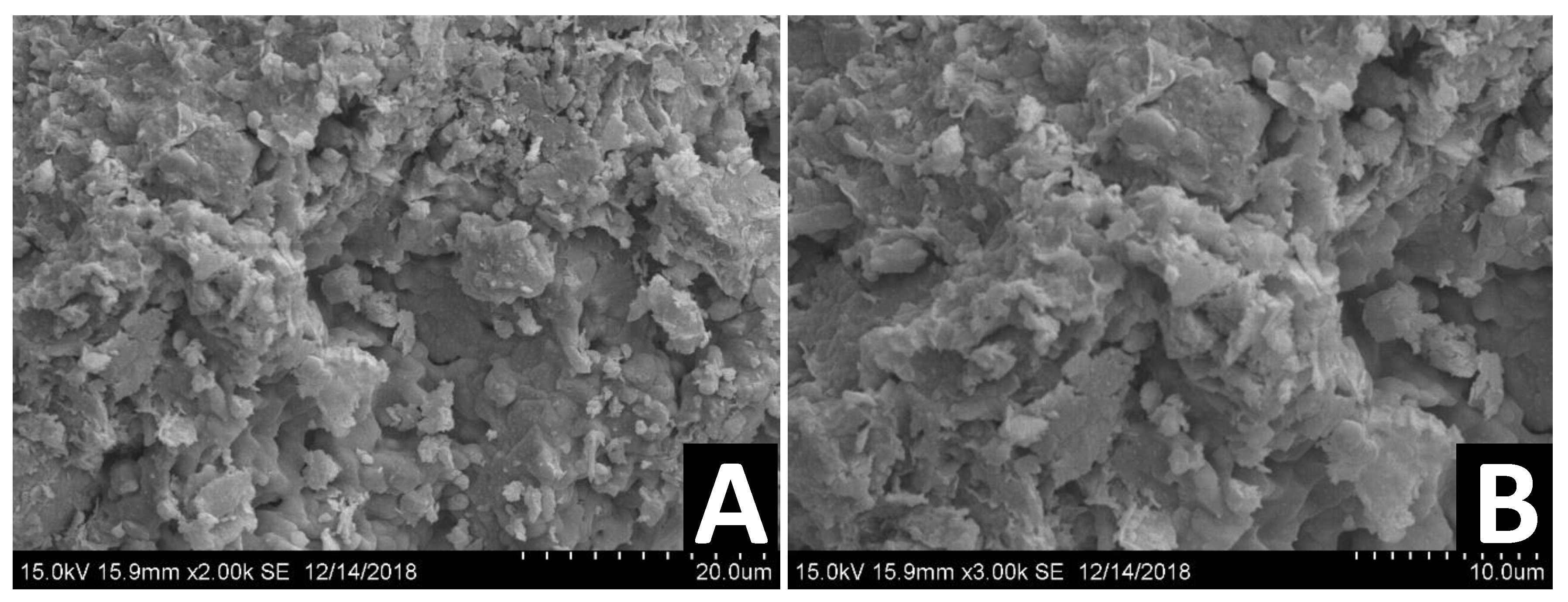
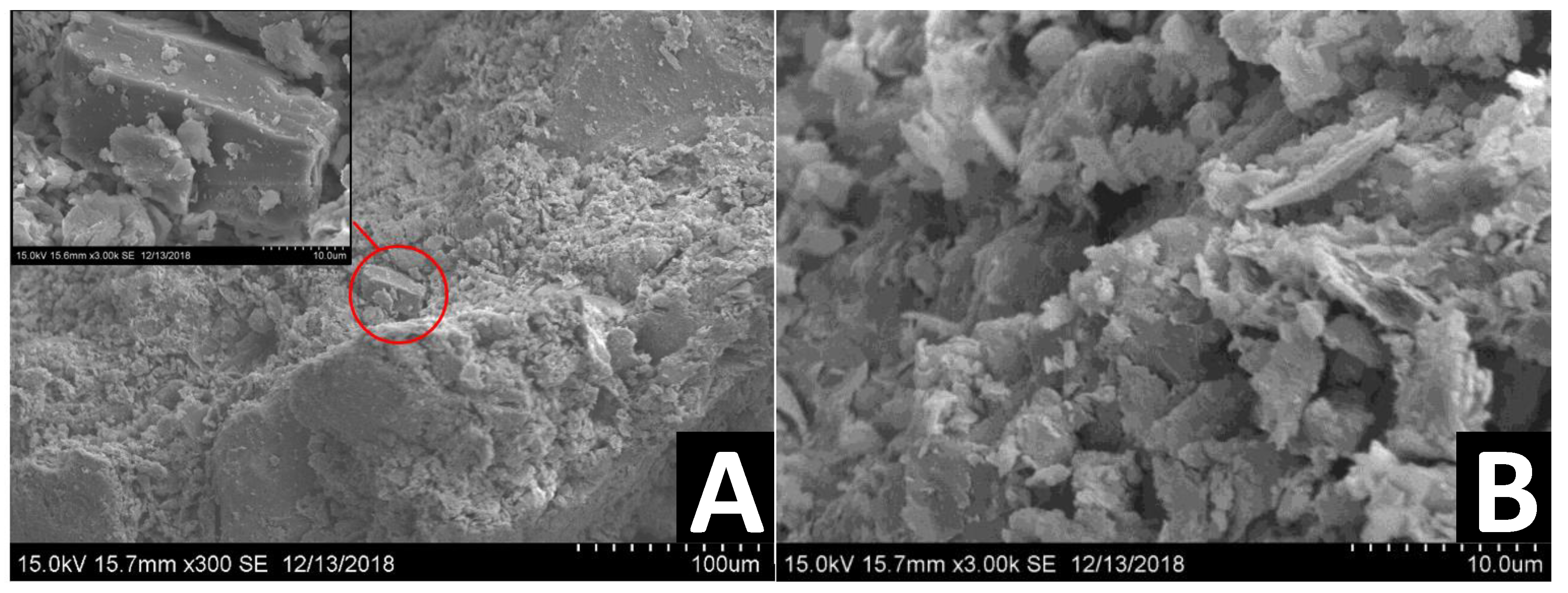
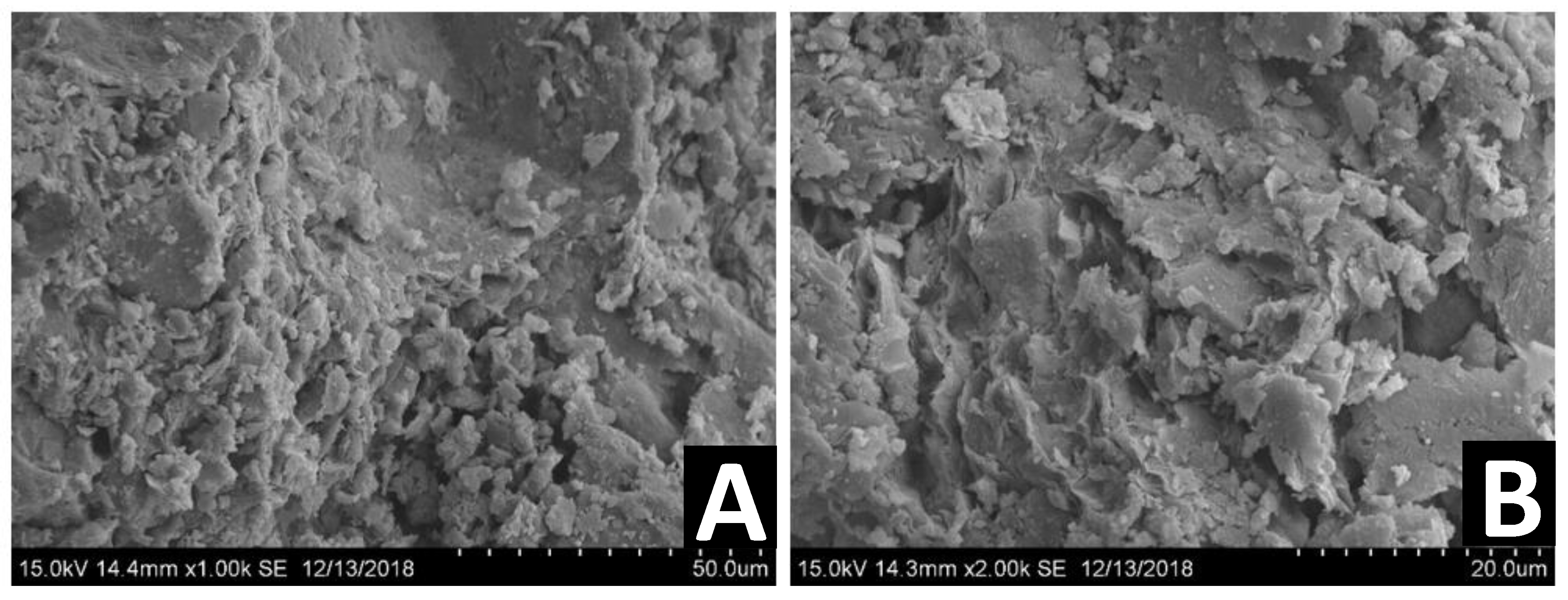
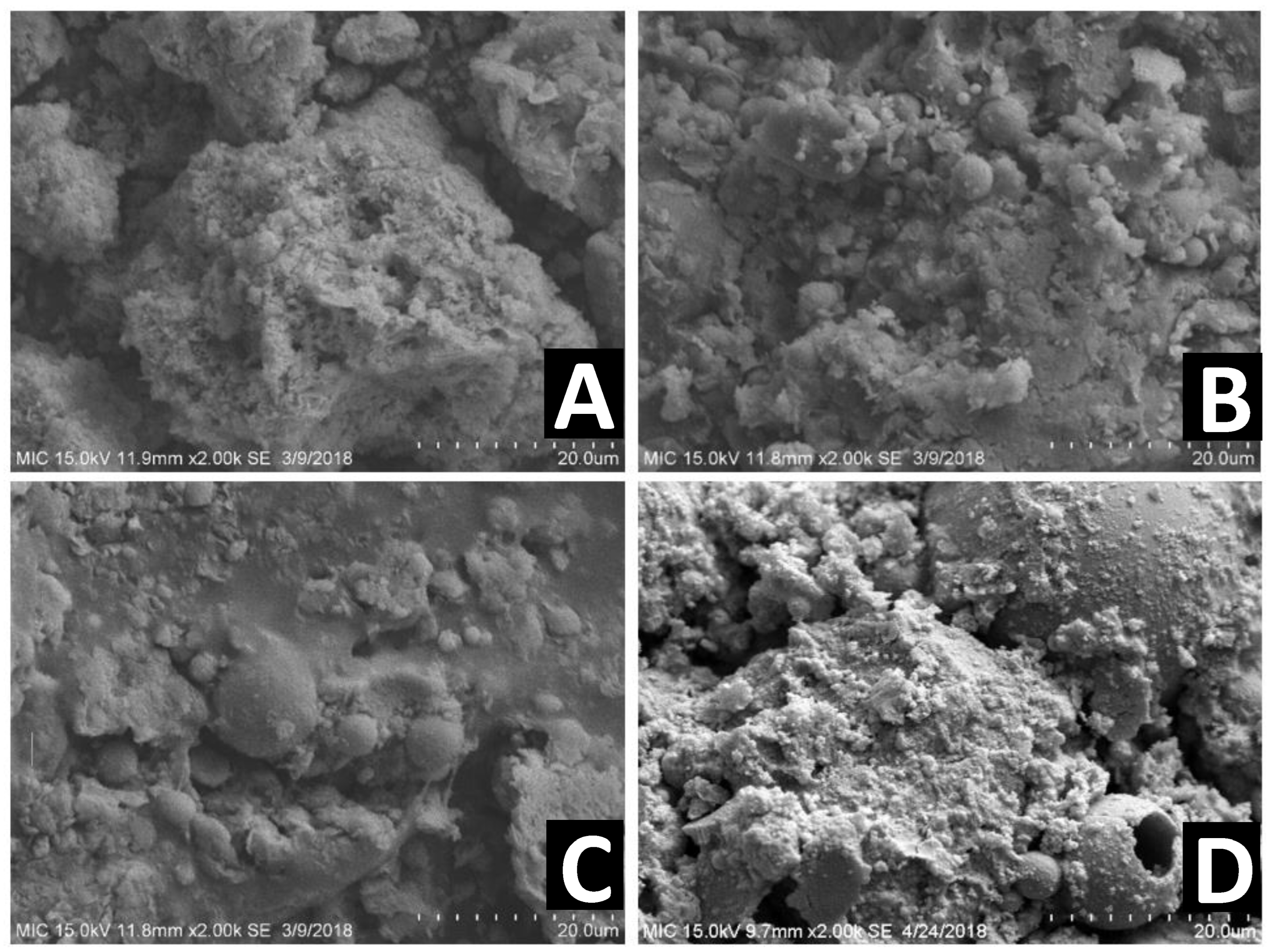

| Analyte | Concentration (mg/L) | Reporting Limit (mg/L) |
|---|---|---|
| Antimony | <0.100 | 0.100 |
| Arsenic | <0.050 | 0.050 |
| Barium | 0.147 | 0.050 |
| Beryllium | <0.050 | 0.050 |
| Cadmium | <0.050 | 0.050 |
| Chromium | <0.050 | 0.050 |
| Lead | <0.250 | 0.250 |
| Nickel | <0.050 | 0.050 |
| Selenium | <0.050 | 0.050 |
| Silver | <0.050 | 0.050 |
| Tests Conducted | Property Description | 5C Combined |
|---|---|---|
| Particle Size | F200 | 93.5 |
| % of Clay | 56.8 | |
| % of Silt | 36.7 | |
| % of Sand | 6.5 | |
| UCS (kPa) | 258.4 | |
| Unit Weight (kN/m3) | 11.59 | |
| Moisture Content (%) | 57 | |
| Specific Gravity (g/cm3) | 2.68 | |
| Hydraulic Conductivity | 9.70 × 10−8 | |
| Organic Content | 2.85 | |
| Proctor | γd,max (kN/m) | 13.86 |
| ωopt (%) | 29 | |
| Atterberg Limits (%) | Liquid Limit | 80 |
| Plastic Limit | 28 | |
| Plasticity Index | 52 |
| Reference | No. | Soil ID | S.G. | UCS | LL % | PI % | Fine Fraction% | Sand Fraction% | Gravel% | CBR | |||
|---|---|---|---|---|---|---|---|---|---|---|---|---|---|
| g/cm3 | kPa | psi | Clay | Silt | Fine | Coarse | |||||||
| (Milburn and Parsons 2004) [17] | 1 | Stevens Soil (SM) | 2.68 | 150 | 21.76 | 20 | 3 | 30 | 70 | - | - | ||
| (Venkatasubramanian et al., 2011) [61] | 2 | Soil III | 2.38 | 92 | 13.34 | 30 | 5 | 12.5 | 10.9 | 67.4 | 9.2 | 4.48 | |
| 3 | Soil II | 2.11 | 182 | 26.40 | 28 | 6 | 8 | 4 | 82 | 6 | 7.5 | ||
| 4 | Soil I | 2.25 | 115 | 16.68 | 46 | 6 | 20 | 20 | 41.6 | 18.4 | 9 | ||
| (Milburn and Parsons 2004) [17] | 5 | Atwood Soil (ML) | 2.75 | 219.52 | 31.84 | 30 | 7 | 88 | 12 | 0 | - | ||
| (Marasteanu et al., 2005) [30] | 6 | Soil II | _ | 269.93 | 39.15 | 25.8 | 9.4 | 14.5 | 45.5 | 40 | - | ||
| (Shankar et al., 2009) [50] | 7 | Lateric Soil + Sand | 2.45 | 142 | 20.60 | 35 | 10 | 2 | 29 | 50 | 19 | 8 | |
| (Milburn and Parsons 2004) [17] | 8 | Hugoton Soil | 2.69 | 308.9 | 44.80 | 35 | 16 | 66 | 34 | 0 | - | ||
| (Ramesh and Sagar 2015) [49] | 9 | Red Earth-CL | 2.59 | 414 | 60.05 | 39 | 17 | 18.24 | 45.76 | 36 | 0 | 0 | 7 |
| (Khan and Taha 2015) [47] | 10 | UKM Soil-CL | 1.75 | 269 | 39.02 | 42.3 | 19.5 | 29.6 | - | - | - | - | - |
| (Nandini et al., 2015) [43] | 11 | Red Soil | 2.67 | 82.6 | 11.98 | 31.5 | 19.9 | 71 | 29 | 0 | - | ||
| (Sen and Singh 2015) [44] | 12 | Black Cotton-CH | 2.48 | 346.17 | 50.21 | 61.4 | 27.4 | 68.7 | 20.87 | 10.43 | 0 | 2.86 | |
| Present Study | 13 | Field Soil/CH-fat clay | 2.65 | _ | _ | 64 | 45 | 40 | 52 | 8 | 0 | 0 | 2 |
| Present Study | 14 | DM-CH | 2.68 | 258.42 | 37.48 | 80 | 52 | 56.8 | 36.7 | 5.3 | 1.2 | 0 | - |
| (Marasteanu et al., 2005) [30] | 15 | Soil I | 2.728 | 432.58 | 62.74 | 84.9 | 52 | 75 | 21 | 4 | 0 | - | - |
| Parameter | Coefficient | Standard Error | p-Value | Model Properties |
|---|---|---|---|---|
| Intercept | −1.272 | 0.278 | <0.001 | |
| Curing time (days) | 0.120 | 0.008 | <0.001 | |
| Dused/Drec | 1.049 | 0.182 | <0.001 | |
| (Dused/Drec) × (Clay fraction) | −0.600 | 0.147 | <0.001 | |
| R2 | 0.85 | |||
| Observations | 55 |
| Parameter | Coefficient | Standard Error | p-Value | Model Properties |
|---|---|---|---|---|
| Intercept | −4.998 | 1.281 | <0.001 | |
| Fine fraction | 4.103 | 1.573 | 0.012 | |
| Clay fraction | 2.885 | 0.572 | <0.001 | |
| Dused/Drec | 2.092 | 0.255 | <0.001 | |
| LL | −0.022 | 0.002 | <0.001 | |
| Curing time (day) | 0.823 | 0.075 | <0.001 | |
| Fine fraction × Curing time | −0.788 | 0.075 | <0.001 | |
| Clay fraction × Dused/Drec | −2.097 | 0.308 | <0.001 | |
| LL × Curing time | −0.004 | 0.001 | <0.001 | |
| PI × Curing time | 0.005 | 0.001 | <0.001 | |
| R2 | 0.90 | |||
| Observations | 66 |
| Type of Test | Testing Method |
|---|---|
| Material Passing Sieve No. 200 | (ASTM D1140) |
| Moisture Content of Soil | (ASTM D2216) |
| Grain Size Analysis including Hydrometer | (ASTM D422) |
| Unconfined Compressive Strength of Cohesive Soil | (ASTM D2166) |
| Specific Gravity of Soil | (ASTM D854) |
| Liquid Limit and Plastic Limit | (ASTM D4318) |
| Standard Compaction (Proctor) Effort | (ASTM D698) |
| Organic Content Ignition Oven Method | (ASTM D2974) |
| Unit Weight (Density) of Soil Specimens | (ASTM D7263) |
Disclaimer/Publisher’s Note: The statements, opinions and data contained in all publications are solely those of the individual author(s) and contributor(s) and not of MDPI and/or the editor(s). MDPI and/or the editor(s) disclaim responsibility for any injury to people or property resulting from any ideas, methods, instructions or products referred to in the content. |
© 2023 by the authors. Licensee MDPI, Basel, Switzerland. This article is an open access article distributed under the terms and conditions of the Creative Commons Attribution (CC BY) license (https://creativecommons.org/licenses/by/4.0/).
Share and Cite
Rabbanifar, S.; Nguyen, T.T.M.; Qian, Q.; Brake, N.A.; Kibodeaux, K.; Crochet, H.E.; Oruji, S.; Whitt, R.L.; Farrow, J.S.; Belaire, B.G.; et al. Reusing Dredged Material through Stabilization with So-Called Bio-Enzyme Products. Buildings 2023, 13, 2618. https://doi.org/10.3390/buildings13102618
Rabbanifar S, Nguyen TTM, Qian Q, Brake NA, Kibodeaux K, Crochet HE, Oruji S, Whitt RL, Farrow JS, Belaire BG, et al. Reusing Dredged Material through Stabilization with So-Called Bio-Enzyme Products. Buildings. 2023; 13(10):2618. https://doi.org/10.3390/buildings13102618
Chicago/Turabian StyleRabbanifar, Saeed, Thi Thuy Minh Nguyen, Qin Qian, Nicholas A. Brake, Kyle Kibodeaux, Harold E. Crochet, Soheil Oruji, Remington L. Whitt, Joshua S. Farrow, Brandon G. Belaire, and et al. 2023. "Reusing Dredged Material through Stabilization with So-Called Bio-Enzyme Products" Buildings 13, no. 10: 2618. https://doi.org/10.3390/buildings13102618








